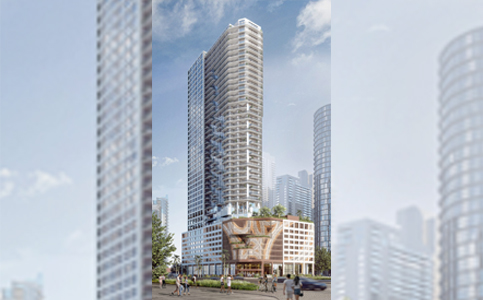42-story Edgewater tower a smaller plan

There is a new mixed-use residential tower coming to Miami’s Edgewater neighborhood.
The development is a modification of an earlier project first approved in 2018 but not pursued.
The redesigned structure is to be 42 stories, home to 544 residential units and 10,106 square feet of ground floor retail, all on a site at 1775 Biscayne Blvd.
The city’s Urban Development Review Board has recommended approval with one condition: that the developer explore a redesign of the parking podium to be more harmonious with the tower.
Javier F. Aviñó, an attorney representing owner-developer 1775 Biscayne L/Cal LLC, said the project will be an attractive, pedestrian-friendly, mixed-use development that contributes to the residential base of Miami’s urban core.
“The project will fill one of the neighborhood’s largest empty development sites and serve as a gateway to the Biscayne Boulevard corridor,” Mr. Aviñó wrote in a letter to the city.
The property is east of Biscayne Boulevard, north of Northeast 17th Terrace and west of Northeast Fourth Avenue. It is near Margaret Pace Park on Biscayne Bay.
He said the plan approved in 2018 included a 53-story mixed-use tower with residential, lodging, office, and retail uses, and incorporated six waivers from the Miami 21 zoning ordinance.
Mr. Aviñó said the project will no longer include lodging or office uses, and will instead devote a greater share of the development program to multi-family residential uses.
Mr. Aviñó wrote, “The project includes significant reductions in height (from 53 stories to 42 stories) and intensity (from 1,219,400 square feet to 808,199 square feet of overall floor area). Additionally, the project features reimagined podium and tower designs, while maintaining the same general development configuration contained in the approved plans.
“Among the changes to the podium design includes a garage screen composed of custom cement breeze blocks which form an artistic feature through concentrations of color and rotation of the blocks.
“From a distance the block pattern creates a graphic which speaks to Miami’s rich culture of murals and graffiti, while up close, the breeze block materiality and thickness evoke decorative architectural screens found throughout Latin America and tropical climates,” he wrote.
Project architect is ODP Architecture and Design of Hollywood. The garage screen design consultant is Camber Studio of Brooklyn.
The developer is requesting modifications to some of the following waivers, which were approved in 2018:
■Waiver for 30% parking reduction: Because the project eliminates lodging units and increases multi-family residential uses, the overall parking requirement has increased to 897 spaces, or 628 spaces after application of the 30% reduction.
■Waiver for parking in second layer on secondary frontage: An art treatment screening the garage has been added.
■Waiver to increase floorplate length above the eighth story.
■Waiver for 10% increase in lot coverage.
■Waiver for reduction in drive aisle width.
In addition, the developer is requesting two new waivers that would allow:
■Parking in the secondary layer on primary frontage.
■Substitution of one commercial loading berth for two residential loading berths.
Review board members expressed dislike of the façade screening on the garage podium levels.
Board member Anthony Tzamtzis said he was not happy with the very rigid grid.
“The checker pattern of the openings are too repetitive, too small, too many beams and little fragmented squares. Why do you have so many little squares? I don’t understand,” said Mr. Tzamtzis.
Board member Agustin Barrera suggested the designers “soften” the base of the building.
Chairman Ignacio Permuy said, “I see two beautiful works of art that collide and in that collision it doesn’t work. They’re two different projects … and they don’t belong together … It needs to blend more.”
Mr. Barrera also mentioned a collision of design.
He said, “I love the organic shape of the building, that’s throughout. It’s on the amenity level, it’s on the floor plane, it’s everywhere … then you have this collision of the corner with that grid.”
Otherwise, it is a beautiful project, said Mr. Barrera.
Mr. Aviñó said, “I think what I’m hearing the board say is refinement. You’re liking both pieces, you just want it more refined.
“There are more ways that we can certainly … focus on that corner, extending it out, and looking at the east façade which seems to be of a slightly different manner, and applying some of that to the façade on the west, which would again start connecting … the two pieces. If the board is amenable to that,” he said.
Mr. Permuy responded, “Very well said, Javier. There is a big disconnect between the two … from form, from color, from the choice of materials, from glass on the tower (and) nothing on the podium … they’re really not coming together.”
Mr. Tzamtzis agreed and said, “We’re only talking about the base, the podium, because the tower is very well articulated.”
Mr. Permuy said it would be a challenge to bring the two together but he believes it can be done.
“I know you guys could make it work,” he said.
Mr. Tzamtzis suggested the developer study the composition of the podium to provide more uniformity, to try to extend the art concept on the corner on more of the podium elevations.
Mr. Barrera made the motion to approve with a condition that the developer “go back and explore taking the artwork that’s in the corner … explore taking the corner element and extending it into both the west and the south facades … so that it’s not so rigid.”
The motion passed unanimously.







Recent Comments